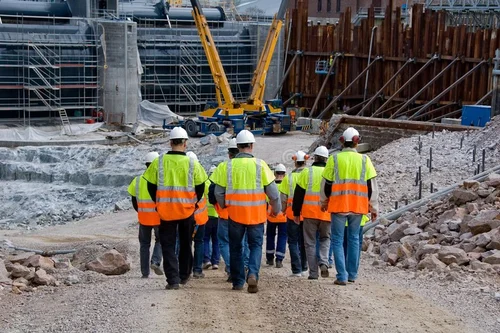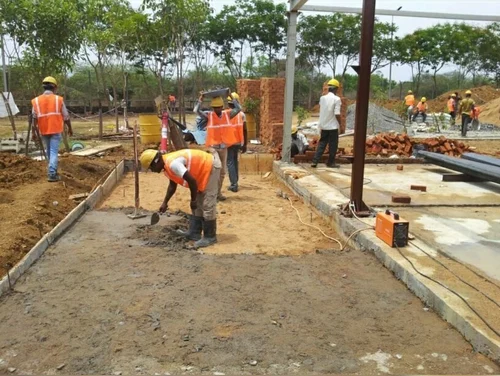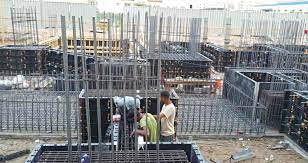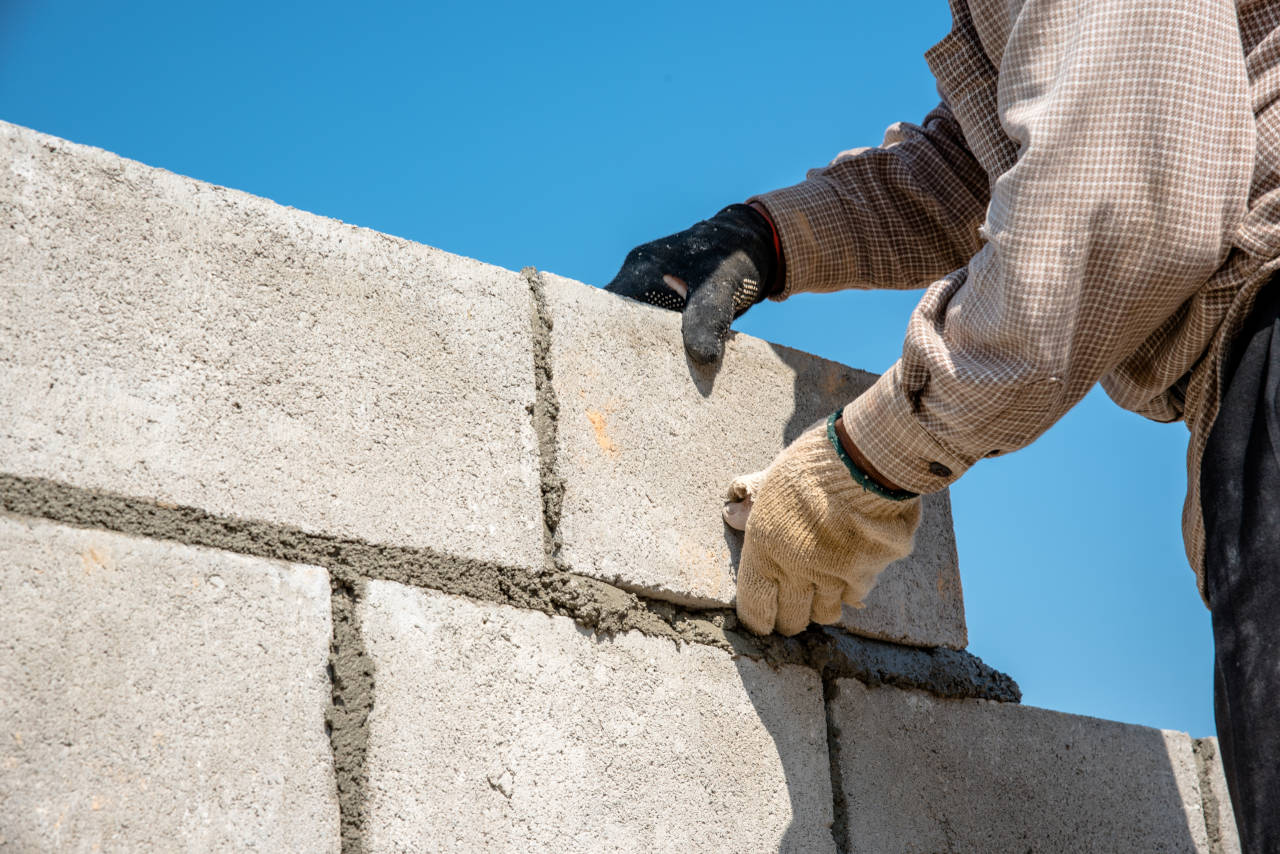Helper Mason (6 month course)
Helper Mason click here
Brief Job Description
This job role is responsible for identification, handling and use of tools and tackles, materials and
equipment. The responsibilities also include site clearance, providing support for masonry works, carrying
out mortar & cement concrete mixing, curing of structure and erection and dismantle of temporary
scaffolding. The individual should have good knowledge about the environment, health, safety and safe
working practices.

Personal Attributes
The individual is expected to be physically fit and should be able to work across various locations in
extreme weather/site conditions. The person should be able to perform efficiently within a team, handle
the various masonry tools and materials and work responsibly.
Erect and dismantle temporary scaffold up to 3.6 meter height
Description
This unit describes the skills and knowledge required to erect and dismantle 3.6 meter temporary scaffold
Scope
The scope covers the following :
Erect and dismantle temporary scaffold up to 3.6 meter height
Elements and Performance Criteria
Erect and dismantle temporary scaffold up to 3.6 meter height
To be competent, the user/individual on the job must be able to:
PC1. level area where scaffold need to be erected and check for ground compactness if required
PC2. shift and stack required materials, components, tools and tackles at the instructed location
PC3. wear and use required safety gadgets and follow trade safety
PC4. place base plates and sole boards on the ground as per markings and instructions
PC5. use proper components and follow standard procedure for erecting temporary scaffold up to
3.6 m
PC6. check verticality of scaffold at first level of erection and correct (if required) before moving to
the next level
PC7. check for rigidity, stability and support of erected scaffold
PC8. fix walk-boards, guard rails, toe-boards and other components on working platform
PC9. follow standard procedure for dismantling of temporary scaffold up to 3.6 m
PC10. remove guard rails, toe boards, walk boards and other components sequentially
PC11. clean and stack all components properly after dismantling
PC12. maintain tidiness at work location
Knowledge and Understanding (KU)
The individual on the job needs to know and understand:
KU1. standard procedure for scaffolding works
KU2. safety rules and regulations for handling and storing scaffolding tools, materials and
components
KU3. personal protection including use of safety gears and equipment
KU4. request procedure for tools & materials
KU5. housekeeping & other administrative rules
KU6. use of different types of scaffolds (cup-lock , frame scaffold)
KU7. use of different types of scaffolds (cup-lock, frame scaffold)
KU8. use of tools and tackles in scaffolding works
KU9. identification and use of different components
KU10. use of tools for measurements and marking
KU11. basic arithmetic calculation
KU12. units of measurements
KU13. standard size of scaffolding components
KU14. personal protective equipment for safety
KU15. importance of housekeeping
KU16. standard procedure for erection and dismantling of 3.6 m temporary scaffold
KU17. tools and equipment used for erecting and dismantling 3.6 meter temporary scaffold
Generic Skills (GS)
User/individual on the job needs to know how to:
GS1. write in one or more language, preferably in the local language of the site
GS2. read one or more language, preferably the local language of the site
GS3. read instructions, guidelines, sign boards, safety rules & safety tags
GS4. speak in one or more language, preferably in one of the local languages of site
GS5. listen and follow instructions / communication shared by superiors/ co- workers regarding
team requirements or interfaces during work processes
GS6. orally communicate with co-workers regarding support required to complete the respective work
GS7. decide whether the workplace is safe for working and also whether the
GS8. identify and organize right scaffolding materials
GS9. identify and use relevant tools effectively

GS10. complete work as per agreed time and quality
GS11. minimize wastages
GS12. revert to superior for selection/sorting of materials
GS13. identify location at which violation of any safety norms may lead to accidents
Identify, handle, shift and store materials, tools & equipment relevant to masonry work
Description
This unit describes the skills and knowledge required to identify, handle, shift and store materials, tools &
equipment relevant to masonry work
Scope
The scope covers the following :
Identify, select and use hand tools & equipment relevant to masonry work
Identify, handle, select and store materials relevant to masonry works
Carry out housekeeping works and dispose waste safely as per organizational guidelines
Elements and Performance Criteria
Identify, select and use hand tools & equipment relevant to masonry work
To be competent, the user/individual on the job must be able to:
PC1. identify basic masonry tools and equipment such as: measurement tape trowel, mortar pan
bolster chisel, spade, rubber/wooden hammers and mallets wedges, jointers, square plumb
bob, straight edge spirit level, water level tube, line thread sponge, volume box, weighing
balance tile scribes or hand held tile cutters, screeds, floats power wet saws, electric drills,
anglers and grinders, vibrators hand operated concrete mixer
PC2. check for serviceability/safety of tools and report faults to superiors
PC3. select and use appropriate hand tools relevant to the task
PC4. set up and use basic leveling devices like plumb bob, spirit level &water level
PC5. clean and maintain tools prior to and after use
Identify, handle ,select and store materials relevant to masonry works
To be competent, the user/individual on the job must be able to:
PC6. identify and select common construction materials used at the construction site such as
bricks, blocks, stones, cement, mortar, concrete, tile, marble, granite, glass, admixtures and
chemicals for the relevant work
PC7. differentiate between various types of material and their appropriate use
PC8. apply appropriate technique of lift & shift by involving push and pull to shift required
materials and tools
PC9. follow standard methods and sequence of loading and unloading of materials such as
cement, , sand, aggregate, tile, marble, stone, admixtures and chemicals
PC10. carry out proper tagging and bagging of materials prior to storing
PC11. follow set procedure while storing and stacking of materials for easy identification and
retrieval
PC12. handle and store hazardous and flow able material like adhesive, admixtures and other
construction chemicals appropriately
PC13. carry out handling and storing of material recognizing and utilizing individual work and team
work as per applicability
Carry out housekeeping works and dispose waste safely as per organizational guidelines
To be competent, the user/individual on the job must be able to:
PC14. carry out housekeeping works prior to, during and after relevant work & clear work place of
all debris and unwanted material
PC15. handle waste material correctly and safely in accordance with the environmental and
organization policies
PC16. handle hazardous material effectively and safely and remove toxic material applying correct
procedures as per instructions
PC17. dispose waste material safely in accordance with environmental and organization policies
Knowledge and Understanding (KU)
The individual on the job needs to know and understand:
KU1. standard practices of masonry works
KU2. safety rules and regulation for handling and storing required masonry tools, equipment and
materials
KU3. personal protection including the use of related safety gears & equipment
KU4. how to request tools and materials as per set procedures
KU5. maintenance of tools and equipment
KU6. standard sizes of relevant masonry tools
KU7. basics of masonry, plastering, concreting , flooring and cladding works using tiles and stones
KU8. different type of masonry tools and their maintenance and care
KU9. how to use the basic masonry and concreting tools and equipment such as measurement
tape, trowel, bolster chisel, mortar pan, hammer, spade, rubber/wooden hammers, mallets,
wedges, jointers, square, plumb bob, straight edge spirit level, water level tube, line thread,
sponge, volume box, weighing balance, tile scribes or hand-held tile cutters, screeds, floats,
power wet saws, electric drills, anglers and grinders, vibrators & hand operated concrete
mixer
KU10. basic leveling devices like plumb bob, spirit level &water level ,their setting and use
KU11. transferring levels using basic leveling devices like plumb bob, spirit level &water level
KU12. how to identify materials such as cement, sand, aggregate, brick, block, stones, marble slabs
& tiles of different types ,admixtures and chemicals
KU13. visual check for quality of bricks, blocks, tiles, stones etc.
KU14. procedure for collecting the materials and tools from store & importance of indent during
receiving/returning materials and tools in store
KU15. arranging shortest possible route for shifting materials & use conveyance equipment for
movement of materials
KU16. height up to which each materials should be stacked and stacking of various materials by as
per the nature, size and shapes and space available
KU17. methods and sequence of loading, unloading of materials such as cement,
KU18. classification and storage of materials as per the uses and compositions
KU19. process of tagging and bagging materials and its relevance
KU20. various techniques / procedures for basic material handling
KU21. maintain correct body posture while lifting & shifting of materials as per ergonomic
principles

KU22. handling and stacking of hazardous materials based on its inflammable nature
KU23. how to select and use appropriate tools and equipment used for handling various materials
(including heavy and hazardous materials)
KU24. housekeeping procedures required in the workplace
KU25. safe disposal of waste
Generic Skills (GS)
User/individual on the job needs to know how to:
GS1. write in at least one language, preferably in the local language of the site
GS2. read in at least one language, preferably the local language of the site
GS3. read instructions, guidelines, sign boards, safety rules and safety tags
GS4. read instructions and exit routes during emergency
GS5. speak in one or more language, preferably in one of the local languages of the
GS6. listen and follow instructions communicated by supervisors
GS7. communicate orally and efficiently with team member
GS8. decide whether the workplace is safe for working and also the relevant work is not creating
hazardous conditions for others
GS9. plan self-work as per the direction /close supervision of a level-2 mason and above
GS10. ensure work is done within time and as per desired quality as per instructions provided by
superiors
GS11. identify location at which violation of any safety norms may lead to accident
Prepare cement mortar /concrete mix and carry out curing of masonry structure
Description
This unit describes the skills and knowledge required to prepare cement mortar /concrete mix and carry
out curing of masonry structure
Scope
The scope covers the following :
Prepare cement mortar and concrete mix for relevant masonry works
Carry out curing of finished brick/block, tile/stone ,concrete and plastered surfaces
Elements and Performance Criteria
Prepare cement mortar and concrete mix for relevant masonry works
To be competent, the user/individual on the job must be able to:
PC1. select a clean ,dry and level surface for preparing cement mortar/concrete mix and select
appropriate material and tools for preparing mortar mix
PC2. sieve fine aggregate (sand) for mortar mix with specified grade sieve wire as per applicability
PC3. weigh/measure the dry ingredients correctly by using appropriate measuring / weighing scales
PC4. select the additives according to mix requirements or as per the instructions from the superiors
PC5. move and position the hand operated concrete mixer appropriately
PC6. batch the materials for mortar/concrete mixing as per instruction and mix uniformly in hand
held concrete mixer
PC7. spread materials on mixing bed for manual mixing according to type of mix required
(concrete or mortar)
PC8. mix mortar uniformly and maintain consistency, plasticity and workability
PC9. add appropriate additives as per the requirements /instruction
PC10. soak brick/block and tiles/stones prior to use as per instructions
PC11. carryout pre wetting of base surface prior to commencement of work
PC12. clean the mixing tools after and prior to use
Carry out curing of finished brick/block, tile/stone ,concrete and plastered surfaces
To be competent, the user/individual on the job must be able to:
PC13. identify appropriate curing method in accordance with the structure and as per instruction
PC14. cure finished brick/block, tile/stone ,concrete and plastered surfaces using appropriate
techniques
PC15. maintain presence of water and prevent the loss of water as per the guidelines by superiors
by using: Ponding Spraying and Wet coverings Plastic Sheets
PC16. spray water on the concrete slabs / cement plaster with appropriate tools as per the
requirement/instruction
PC17. cover the concrete surface with hessian cloth/polythene to retain water and effective curing
PC18. minimize wastage and effectively use water for curing
Knowledge and Understanding (KU)
The individual on the job needs to know and understand:
KU1. standard practices of masonry works
KU2. safety rules and regulation for handling and storing required masonry tools, equipment and
materials
KU3. personal protection including the use of related safety gears & equipment
KU4. how to request tools and materials as per set procedures
KU5. maintenance of tools and equipment
KU6. types of materials required for cement mortar, concrete mix including other bonding
materials
KU7. ratio of materials required for mixing mortar and concrete by volume
KU8. methodology for preparation of platform, placing and mixing of ingredients
KU9. how to select and use hand tools and equipment such as wheel barrow,
KU10. how use appropriate measuring volume box/ weighing scales for measuring the appropriate
quantity of materials required
KU11. how to mix the dry ingredients with appropriate water and additives if required
KU12. how to identify different admixtures used in masonry works like accelerators, retarders, antifreeze compounds like calcium chloride, coloring pigments, evaporative retarders and
adhesives for tiles and stones
KU13. different types of mixing of concrete like manual mixing and mechanical
KU14. how to move, place and operate the hand operated concrete mixer
KU15. how to store empty cement bags
KU16. basics of various curing techniques such as Ponding Spraying and Wet coverings Plastic
Sheets
KU17. use of correct quantity of water to be sprayed as per the requirements to
KU18. use of appropriate type of polythene /hessian cloth to prevent loss of moisture
Generic Skills (GS)
User/individual on the job needs to know how to:
GS1. write in at least one language, preferably in the local language of the site
GS2. read in at least one language, preferably the local language of the site
GS3. read instructions, guidelines, sign boards, safety rules and safety tags
GS4. read instructions and exit routes during emergency
GS5. speak in one or more language, preferably in one of the local languages of the
GS6. listen and follow instructions communicated by supervisors
GS7. communicate orally and efficiently with team member
GS8. decide whether the workplace is safe for working and also the relevant work is not creating
hazardous conditions for others
GS9. plan self-work as per the direction /close supervision of a level-2 mason and above
GS10. ensure work is done within time and as per desired quality as per instructions provided by
superiors
GS11. identify location at which violation of any safety norms may lead to accident

Work according to personal health, safety and environment protocol at construction site
Description
This NOS covers the skill and knowledge required for an individual to work according to personal health,
safety and environmental protocol at construction site
Scope
The scope covers the following :
Follow safety norms as defined by organization
Adopt healthy & safe work practices
Implement good housekeeping and environment protection process and activities
Elements and Performance Criteria
Follow safety norms as defined by organization
To be competent, the user/individual on the job must be able to:
PC1. identify and report any hazards, risks or breaches in site safety to the appropriate authority
PC2. follow emergency and evacuation procedures in case of accidents, fires, natural calamities
PC3. follow recommended safe practices in handling construction materials, including chemical
and hazardous material whenever applicable
PC4. participate in safety awareness programs like Tool Box Talks, safety demonstrations, mock
drills, conducted at site
PC5. select and operate different types of fire extinguishers corresponding to types of fires as per
EHS guideline
PC6. identify near miss , unsafe condition and unsafe act
Adopt healthy & safe work practices
To be competent, the user/individual on the job must be able to:
PC7. use appropriate Personal Protective Equipment (PPE) as per work requirements including:
Head Protection (Helmets), Ear protection, Fall Protection, Foot Protection, Face and Eye
Protection, Hand and Body Protection, Respiratory Protection (if required)
PC8. handle all required tools, tackles , materials & equipment safely
PC9. follow safe disposal of waste, harmful and hazardous materials as per EHS guidelines
PC10. install and apply properly all safety equipment as instructed
PC11. follow safety protocol and practices as laid down by site EHS department
PC12. undertake and pass height pass test as per EHS guideline
Implement good housekeeping and environment protection process and activities
To be competent, the user/individual on the job must be able to:
PC13. collect and deposit construction waste into identified containers before disposal, separate
containers that may be needed for disposal of toxic or hazardous wastes
PC14. apply ergonomic principles wherever required
Knowledge and Understanding (KU)
The individual on the job needs to know and understand:
KU1. reporting procedures in cases of breaches or hazards for site safety, accidents, and
emergency situations as per guidelines
KU2. types of safety hazards at construction sites
KU3. basic ergonomic principles as per applicability
KU4. the procedure for responding to accidents and other emergencies at site
KU5. use of appropriate personal protective equipment to be used based on various working
conditions
KU6. importance of handling tools, equipment and materials as per applicable
KU7. health and environmental effect of construction materials as per applicability
KU8. various environmental protection methods as per applicability
KU9. storage of waste including the following at appropriate location: non-combustible scrap
material and debris, combustible scrap material and debris, general construction waste and
trash (non-toxic, non-hazardous), any other hazardous wastes, any other flammable wastes
KU10. how to use hazardous material, in a safe and appropriate manner as per applicability
KU11. types of fire
KU12. Procedure of operating different types of fire extinguishers
KU13. safety relevant to tools, tackles, & requirement as per applicability
KU14. housekeeping activities relevant to task

Generic Skills (GS)
User/individual on the job needs to know how to:
GS1. write in one or more languages, preferably in the local language of the site
GS2. fill safety formats for near miss, unsafe conditions and safety suggestions
GS3. read in one or more language, preferably in the local language of the site
GS4. read sign boards, notice boards relevant to safety
GS5. speak in one or more language, preferably in one of the local language of the site
GS6. listen instructions / communication shared by site EHS and superiors regarding site safety,
and conducting tool box talk
GS7. communicate reporting of site conditions, hazards, accidents, etc.
GS8. maintain safe conditions for others
GS9. keep the workplace clean and tidy
GS10. identify safety risks that affect the health, safety and environment for self and others
working in the vicinity, tackle it if within limit or report to appropriate authority
GS11. assess and analyze areas which may affect health, safety and environment protocol on the
site
GS12. ensure personal safety behavior
GS13. respond to emergency
Carry out manual earthwork at construction site
Description
This unit describes the skills and knowledge required to carry out manual earthwork at construction sites
Scope
The scope covers the following :
Carry out preparatory work prior to earthwork
Carry out soil cutting, dressing work
Carry out backfilling and compaction manually
Elements and Performance Criteria
Carry out preparatory work prior to earthwork
To be competent, the user/individual on the job must be able to:
PC1. remove all the unwanted materials, organic substances, manually removable objects from
the worksite using appropriate hand tools as per instruction
PC2. clean earth surface using proper hand tools to make it ready for carrying out marking activity
PC3. carry out marking for excavation using lime, wooden pegs, ropes or by any other suitable
materials as per instruction
PC4. shift and stack fencing/ barricading materials, safety signage, ladders, ropes, earth cutting
and shifting tools at specified locations as per instruction
Carry out soil cutting, dressing work
To be competent, the user/individual on the job must be able to:
PC5. dig earth to a desired depth using appropriate tools as per instruction
PC6. maintain desired slope of earth during digging activity
PC7. dispose earth from the excavated pit by using suitable tools and equipment’s such as spade ,
wheel barrows, pans as per instruction
PC8. check for loose material, soil lumps, pebbles on achieving the desired earth level
PC9. carry out surface dressing work by disposing loose material, gravels, plant roots, sludge,
muck or debris as per requirement to the appropriate locations
PC10. carry out compaction of the base layer of the pit by ramming or operating hand/ plate
compactor as per instruction
Carry out backfilling and compaction manually
To be competent, the user/individual on the job must be able to:
PC11. shift and place earth at desired location by using right tools as per instruction
PC12. sort gravels or oversized aggregates from soil to be used for backfilling as per instruction
PC13. place and spread earth maintaining uniform layers within tolerance limit of thickness
PC14. sprinkle water as uniformly over the layer to be compacted as and when required as per
direction
PC15. carry out ramming or operate hand/ plate compacting machines over the soil layer as per
direction
PC16. carry out re-filling and compaction of excavated trenches, pits surrounding the structures or
at necessary location by soil under supervision
Knowledge and Understanding (KU)
The individual on the job needs to know and understand:
KU1. general safety rules applicable to different activities related to construction
KU2. administrative rules and regulations applicable to construction sites
KU3. material issue and return procedure at site
KU4. reporting procedures relevant to own job, unsafe/ hazardous conditions
KU5. use and name of hand tools such as spade, pick axe, shovel, pans, wheel
KU6. working at depth at below ground level
KU7. use of marking tools such as wooden pegs, lime, line threads, ropes
KU8. use of plate compactor, hand roller, earth ramming tools etc.
KU9. how to maintain slope in excavation
KU10. use of ladder to access earth pits
KU11. safety related to earthwork
Generic Skills (GS)
User/individual on the job needs to know how to:
GS1. write in at least one language, preferably in the local language of the site
GS2. read in one or more languages, preferably in the local language of the site
GS3. read instructions, guidelines, sign boards, safety rules & safety tags instruction related to
exit routes during emergency at the workplace
GS4. speak in one or more languages, preferably in one of the local languages of the site
GS5. listen and follow instructions / communication shared by superiors/ co- workers regarding
team requirements or interfaces during work processes
GS6. orally communicate with co-workers regarding support required to complete the respective
work
GS7. decide on tools to be used at different activities involved in manual
GS8. sequence activities to be carried out
GS9. decide whether his workplace is safe for working and also his work is not creating hazardous
conditions for other
GS10. identify and use the tools
GS11. identify and use of all safety equipment
GS12. arrange the material for earthwork
GS13. complete work as per time schedule and quality
GS14. determine any violation from organizational and standard safety norms








